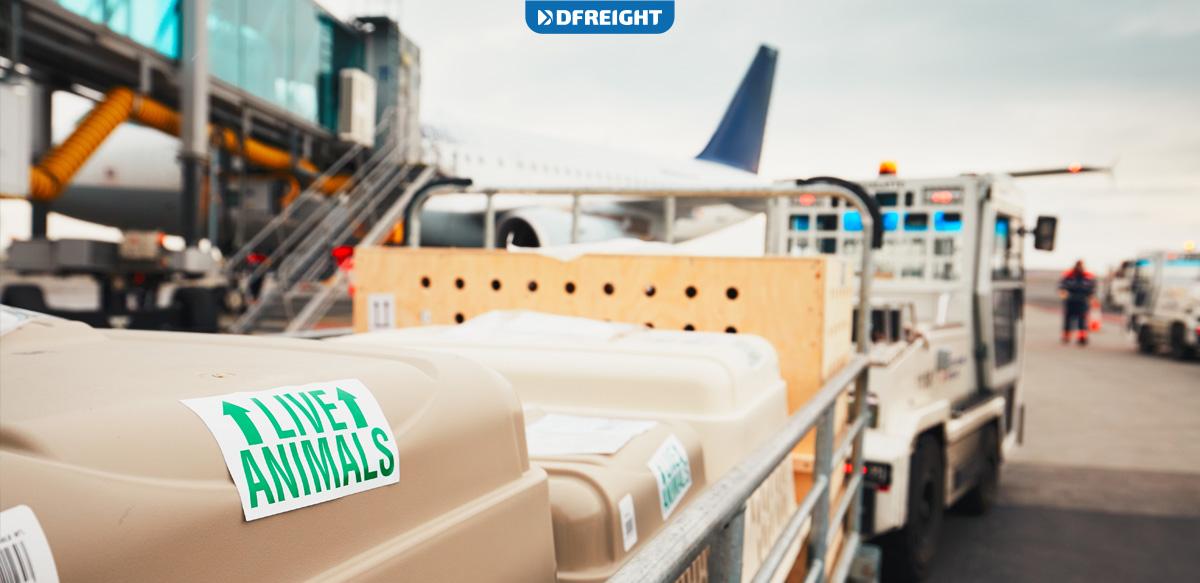Several important factors are needed to ensure a safe and comfortable flight for the animal and the owner when shipping live animals by air. The type of animal, its size and weight, and the climate and weather conditions at the origin and destination airports all play an essential role in deciding how to ship an animal by air. It is also crucial to choose an airline with experience transporting live animals to avoid potential travel problems. For more tips on how to successfully ship a live animal by air, please read this blog post in its entirety!
Table of Contents
Air Freight: The Best Choice for Shipping Live Animals
Live animal transportation is desired for a variety of reasons. Pets or service dogs for the blind and visually impaired may be included. They could be zoo animals or species being moved for scientific purposes, animal breeding for agriculture, food being transported for slaughter, or sporting or zoological animals. Long-distance animal transport is considered unnecessarily cruel and should be avoided wherever possible. So, the only quick choice for long-distance travel is to use an airplane.
Key Factors Considered When Shipping Live Animals by Air
When deciding how best to ship an animal by air, several essential factors must be considered to ensure the safety and welfare of the animal involved. The type of animal being transported will play a significant role in deciding what kind of crate or container is needed and what food and water need to accompany the animal during travel.
It is also essential to consider both airports’ climate and weather conditions to determine if any special accommodations need to be made for the animal. Finally, the flight length is also an essential consideration as shorter flights will typically have less impact on an animal than a longer one.

General Tips for Successful Shipments of Live Animals by Air
There are several things that owners can do to help ensure a successful shipment when transporting live animals by air. First, it is vital to choose an airline with experience shipping live animals to avoid any potential problems during travel. Once you have selected an airline, be sure to contact them well in advance of your travel date and notify them that you will be traveling with a pet or other live animal.
Also, ensure you have all required paperwork ready before arriving at the airport, so there are no delays in getting your animal safely loaded onto the plane. Following these simple tips should help make shipping live animals by air a successful and stress-free experience for all involved!
Rules and Regulations for Shipping Live Animals by Air
Animals have been transported by air since the early 1900s, when the Wright brothers made their historic flight. The first air cargo shipment of live animals occurred in 1910 when two lions were transported from London to New York. Today, shipping live animals by air is a common and necessary practice for many people who own pets or work in the animal industry. There are, however, rules and regulations that must be followed to ensure the safety of the animals and the people handling them.
Since flying is the most ethical method of moving live animals over long distances, it is crucial that all parties involved—veterinarians, animal keepers, handlers, attendants, producers of containers, air carriers, pilots, etc.—maintain high standards. The best way to do this is through regulation and supervision.
To ensure compliance with aviation safety practices and requirements, regulations for shipping live animals must balance treating animals humanely and following current welfare standards. Additionally, the security of the staff, the travelers, and the animal handlers must be considered.
LAR: IATA’s Live Animals Regulations
The International Air Transport Association’s (IATA) Live Animals Regulations (LAR) is a set of guidelines that must be followed when shipping live animals by air. The LAR covers all aspects of the transport process, from the preparation of the animal for travel to handling the animal during the journey. The goal of the LAR is to ensure the safety of the animal and the people involved in the transport process.
IATA’s LAR is recognized as the industry standard for the transport of live animals by air. The LAR is reviewed and updated regularly to reflect the latest scientific research and advances in animal welfare.
Thus, supranational and state regulating authorities refer to IATA’s LAR as the global standard for live animal transportation by commercial aircraft. The LAR is utilized by shippers, freight forwarders, and experts in animal care, in addition to assisting airlines. The LAR includes a complete classification of thousands of animal species and the container requirements for their transit. Additionally, it contains details on how to handle, mark, and label animals, as well as the essential paperwork for air transportation.
Who Must Adhere to the Rules?
The IATA Live Animals Regulations (LAR) must be followed by anyone shipping animals by plane when they are:
- Moving with their live animals or pets.
- Shipping live animals for conservation or zoological purposes.
- Transporting racehorses to and from tournaments.
- Shipping live animals for agricultural or life science purposes
National Regulations for Shipping Live Animals by Air
Air carriers must also ensure that all national rules and regulations are obeyed because compliance with the LAR may not always satisfy these requirements. For instance, the Australian National Consultative Committee on Animal Welfare (NCCAW) deems the LAR as simply essential, minimum criteria, and not entirely sufficient for the sorts of native animals moved interstate throughout Australia. To assist airlines in adhering to LAR requirements and European Regulations, the UK Government has also published its guidelines.
Animal protection during shipping and associated procedures are also covered under European Union Regulation 1/2005. This transnational law protects farmers moving their cattle on the land and transporting livestock by road, rail, sea, and air. It is exclusively applicable to the transport of vertebrates. In addition, compliance with the LAR is mainly required by the EU Regulation.
Furthermore, a comprehensive set of rules for the movement of all live animals has also been created by the Convention on International Trade in Endangered Species of Wild Fauna and Flora (CITES). These guidelines also aim to adhere broadly to the LAR.

How to Prepare for Shipping Live Animals by Air
When shipping live animals, it is essential to follow all the rules and regulations to ensure the safety of the animal and the people involved. Here are the steps you need to take before shipping live animals:
1. Complete All Required Health Examinations
The first step in shipping live animals is to ensure that the animal is healthy and fit to travel. A certified veterinarian should thoroughly examine the animal and provide a health certificate that states that the animal is free of any disease and can travel. The animal should also be vaccinated and have all the necessary paperwork.
2. Make a Reservation for Shipping Live Animals
The second step is to book travel with an airline that accepts live animals. Not all airlines accept live animals, so checking with the airline before booking travel is essential.
When making a reservation, the following factors should be taken into account:
- Species being transported and the appropriate care that must be taken with each one
- Necessary specifications for containers to fit in the aircraft’s hold
- Exclusive carrier rules and regulations for particular species
- Rules and regulations governing the species in the destination country
- The most suitable direct route permitted by the importing country
- Dispatch date
3. Select Appropriate Packaging and Get It Tested
The third step is to choose an appropriate shipping container. The container must be large enough for the animal to stand up, turn around, and lie down in, and it must have adequate ventilation. Your packing should be tested in a package testing lab accredited by the International Safe Transit Association (ISTA) before being shipped.
You can search the ISTA website to identify accredited testing centers. If you have contracted with an experienced pet shipper for overseas travel, they will take care of this obligation on your behalf.
4. Provide Appropriate Precautions for Your Live Animals During Shipping
Considerations that consider these requirements must be added if your live animals need to be transported with food, water, or at a specific temperature. Make sure your animals have enough food and water to last the trip. You need to pack your animal’s crate with plenty of bedding and food and attach a water dish to the inside of the crate.
A larger animal (like a cat or dog) can also benefit from being sedated on a long journey. You can ask your veterinarian what sedatives and dosages would be appropriate for your animal.
5. Prepare the Required Paperwork
Most services demand that you obtain authorization beforehand via an International Special Commodities contract if you decide to transfer your live animals internationally via the postal system. Your preferred shipping company may offer this document. This document must be obtained before hiring a reputable pet shipper.
Import Permit, Health Certification, and Shipper’s Certificate are the minimal paperwork required by shippers for the overseas shipping of live animals.
If you are shipping live animals from the USA, you might need to get your paperwork approved by the USDA Import/Export Office. You can accomplish this by scheduling a meeting at your neighborhood USDA office.
Last Words
The best way to ship live animals by air is to use a professional pet shipping company. These companies are experienced in shipping live animals and will take care of all the necessary details. They will also provide you with support and assistance if there are any problems with the shipment. It is also essential to follow all the rules and regulations to ensure the safety of the animal and the people involved.
If you want to ship your live animals from or to the UAE, contact our Animal Shipment experts at DFreight. They will guide you throughout the entire process and assist you in choosing the most appropriate carrier. Please let us know in the comments if you have any prior experience shipping live animals in the UAE.
FAQs
Why does air ship live animals?
Long-distance animal transport is considered unnecessarily cruel and should be avoided wherever possible. So, the only quick choice for long-distance travel is to use an airplane.
How can I ship a live animal by air?
First, complete all necessary health checkups and book travel with an airline that accepts live animals; then, choose an appropriate shipping container and ensure your animals have enough food and water to last the trip. Finally, prepare the required documents.
What regulations must be followed when shipping live animals by air?
The International Air Transport Association’s (IATA) Live Animals Regulations (LAR) is a set of guidelines that must be followed when shipping live animals by air.
What factors should I consider when shipping live animals by air?
You should consider the type of animal, its size and weight, the climate and weather conditions at both the origin and destination airports, the airline’s pet policy, the animal’s health, the crate, bedding, food, and water.
What documents do I need for shipping live animals by air?
Import Permit, Health Certification, and Shipper’s Certificate are the minimal paperwork required by shippers for the overseas shipping of live animals.














